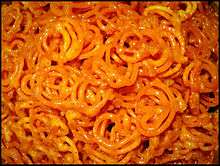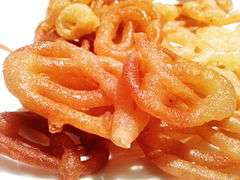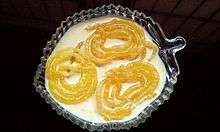Jalebi
 Jalebis as served in India | |
| Alternative names | Jilbi, Jilipi, Jilapi (Bengali), Zelapi, Jilapir Pak, Jilebi (India), Jilawii, Zilafi (Sylheti), Zoolbia (Middle East), Jeri (Nepal), Z'labia (Tunisia) Mushabakh (Ethiopia) |
|---|---|
| Course | Dessert |
| Region or state | South Asia, Middle East, North Africa, East Africa |
| Serving temperature | Hot/Cold |
| Main ingredients | Maida flour, saffron, ghee, sugar |
| Variations | Jahangiri or Imarti |
|
| |

Jalebi, also known as Zulbia, is a sweet popular especially India. It is made by deep-frying maida flour (Plain flour or All-purpose flour) batter in pretzel or circular shapes, which are then soaked in sugar syrup. They are particularly popular in South Asia during Diwali.
The sweets are served warm or cold. They have a somewhat chewy texture with a crystallized sugary exterior coating. Citric acid or lime juice is sometimes added to the syrup, as well as rose water. Jalebi is eaten with curd, rabri (North India) along with optional other flavours such as kewra (scented water).
This dish is not to be confused with similar sweets and variants like imarti and chhena jalebi.
Names
Names for the dish include Hindi: जलेबी; Sanskrit: सुधा-कुण्डलिका, Marathi: जिलबी Bengali: জিলাপি Jilapi or Jilaapi; Sylheti: জিলাফি Zilafi; Telugu: జిలేబి; Kannada: ಜಿಲೇಬಿ; Punjabi: ਜਲੇਬੀ; Gujarati: જલેબી; Urdu: جلیبی; Sindhi: جلیبی; Sinhala: පැණි වළලු; Azerbaijani: zülbiyə (South Azerbaijani: زۆلبیه); Pashto: jalebī; Tamil: ஜிலேபி; Malayalam: ജിലേബി; Pashto: ځلوبۍ źəlobəi; Persian: زولبیا zulbia; Lurish: زلهیبی zuleybi; Arabic: zalābiyah or zalebi (Egyptian Arabic: مِشَبٍك Meshabek, Tunisian Arabic: Zlebia); Tagalog: Jalebie; Harari language: ሙሻበኽ Mushabakh.
History
Jalebi is believed to be derived from a similar dish of India. According to Hobson-Jobson, the word jalebi is derived from the Sanskrit word the name for a similar dish. In western communities in West Asia, it is served on the Feast of the Theophany (Epiphany), often with dry sugar and cinnamon or confectioners sugar.
. In 15th century India, jalebi was known as Kundalika or Jalavallika.[1]:262 Priyamkarnrpakatha, a work by the Jain author Jinasura, composed around 1450 CE, mentions jalebi in the context of a dinner held by a rich merchant.[1]:37[2] Gunyagunabodhini, another Sanskrit work dating before 1600 CE, lists the ingredients and recipe of the dish; these are identical to the ones used to prepare the modern jalebi.[3]
Ernest A Hamwi, a Syrian immigrant to the United States, is believed to have used the Persian version zalabia as an early ice cream cone.[2]:404
Geographic distribution


in addition to being sweetened with honey and sugar is also flavoured with saffron and rose water.
This sweet is called "jeri" in Nepal, a word derived from Jangiri .
In Algeria, Libya and Tunisia, this sweet is known as zlebia or zlabia.
Zlebia (Maghreb)
Zlebia or zlabia (Maghrebi Arabic: زلابية) is a type of pastry eaten in parts of Northwest Africa, such as Algeria, Tunisia and Libya.
Natural ingredients include flour, yeast, yoghurt and sugar or honey. This is then mixed with water and commonly two seeds of cardamom (oil for the crackling).
Zalābiya
Zalābiya are fried dough foods, including types similar to straight doughnuts. These are found in and around Iran and the Arab countries of Yemen, Egypt,[4] Syria, Lebanon, Iraq, Comoros and Algeria, as well as the rest of the Levant. They are made by a zalbāni. Zalābiya are made from a batter composed of eggs, flour and milk, and then cooked in oil.
Zalābiya mushabbaka are latticed fritters made in discs, balls and squares. They are dipped in clarified honey perfumed with rose water, musk and camphor. A recipe from a caliph's kitchen suggests milk, clarified butter, sugar and pepper to be added.
Zalābiya funiyya is a "sponge cake" version cooked in a special round pot on a trivet and cooked in a tannur.[5] They are often stick shaped. They are eaten year-round, including in expatriate communities such as in France, although they are especially popular during Ramadan celebrations.[6]
In popular culture
- Mallika Sherawat (as Kamini[7]) played item song, "Jalebi bai" in the Hindi movie Double Dhamaal.
- Dhara Ghee used jalebi in advertisement.
- Four Tet named a song from his 2013 record Beautiful Rewind "Parallel Jalebi".
- 2015 Bollywood film Phantom had popular song named Afghan Jalebi.
See also
References
- 1 2 Anil Kishore Sinha (2000). Anthropology Of Sweetmeats. Gyan Publishing House. ISBN 978-81-212-0665-5.
- 1 2 Alan Davidson (21 August 2014). The Oxford Companion to Food. Oxford University Press. pp. 424–425. ISBN 978-0-19-967733-7.
- ↑ Dileep Padgaonkar (15 March 2010). "Journey of the jalebi". The Times of India. Retrieved 2014-08-25.
- ↑ Maya Shatzmiller (1993). Labour in the medieval Islamic world. BRILL. p. 110. ISBN 978-90-04-09896-1.
- ↑ Translated by Nawal Nasrallah Annals of the caliphs' kitchens: Ibn Sayyār al-Warrāq's tenth-century Baghdadi cookbook Volume 70 of Islamic history and civilization Edition illustrated 2007 ISBN 978-90-04-15867-2. 867 pages BRILL page 413-417
- ↑ Hadi Yahmid French Ramadan About Solidarity IslamOnline
- ↑ "Double Dhamaal". IMDB. Retrieved 15 November 2013.
External links
-
 Media related to Jalebi at Wikimedia Commons
Media related to Jalebi at Wikimedia Commons